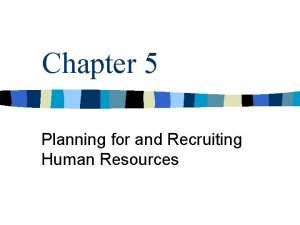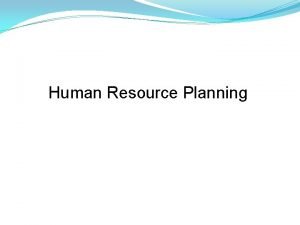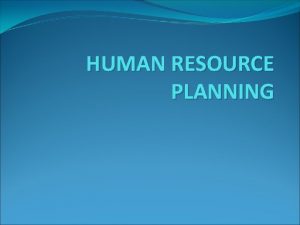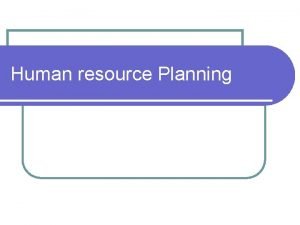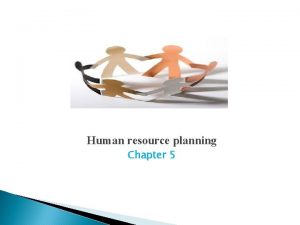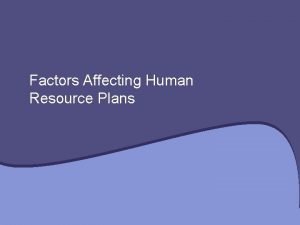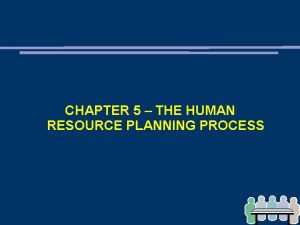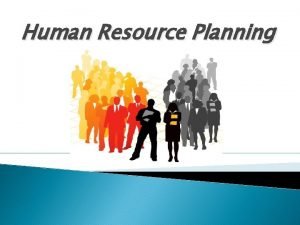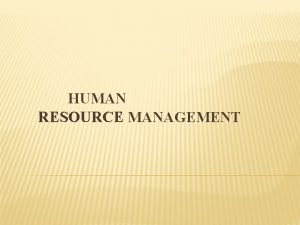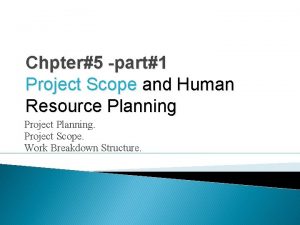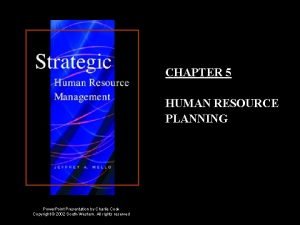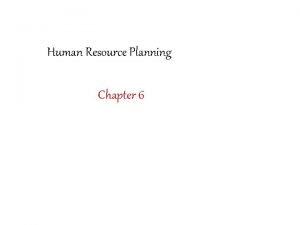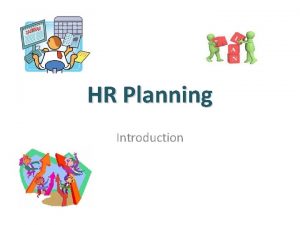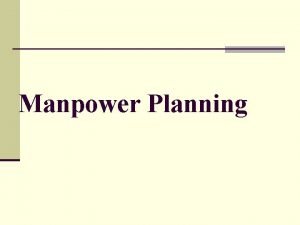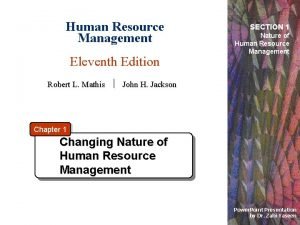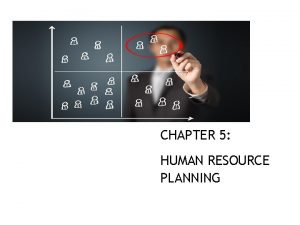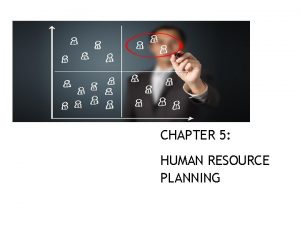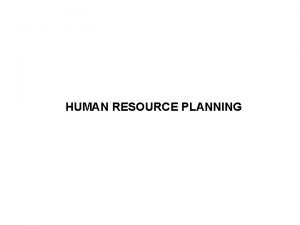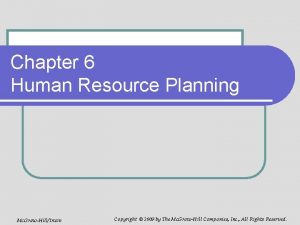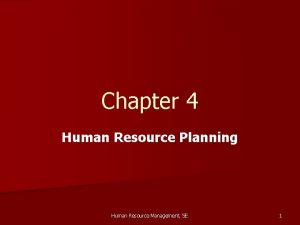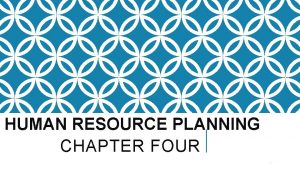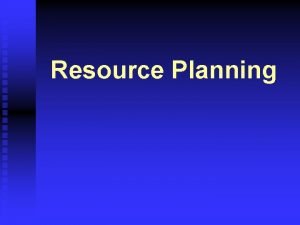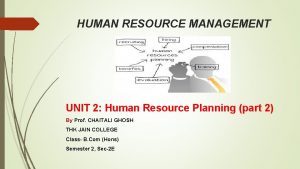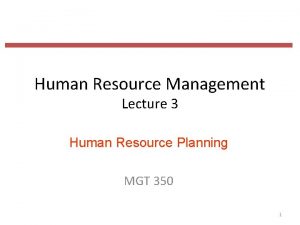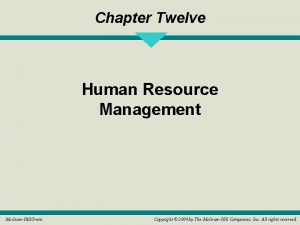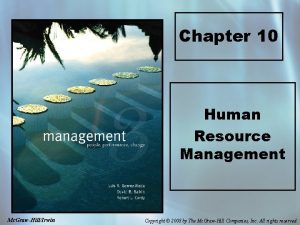Chapter 6 Human Resource Planning Mc GrawHillIrwin Copyright




















- Slides: 20

Chapter 6 Human Resource Planning Mc. Graw-Hill/Irwin Copyright © 2009 by The Mc. Graw-Hill Companies, Inc. , All Rights Reserved.

HR Planning Process Overall Strategic Business Plan Human Resources Plan HR Planning Activities 3 -2

Overview: Human Resource Planning 1. 2. 3. 4. 5. Initial Decisions Forecasting HR Requirements Forecasting HR Availabilities Reconciliation and Gaps Action Planning 3 -3

The Basic Elements of Human Resource Planning 3 -4

The Basic Elements of Human Resource Planning 3 -5

HRP: Initial Decisions l Strategic planning Comprehensiveness l Linkages with larger organizational mission l l Planning time frame l Job categories and levels l What jobs will be covered by a plan? l Head count (current workforce) l Roles and responsibilities 3 -6

HRP: Forecasting HR Requirements l Quantitative l techniques Correlation and regression analysis Correlation – measures relationship between two or more variables l Regression analysis – measures the value of one variable in terms of the other variable l Disadvantage – based on the assumption that the future will resemble the past l l Simulation – computerized model that represents the key features/variables l Useful for “what if” questions 3 -7

HRP: Forecasting HR Requirements l Subjective l l techniques Qualitative information supplied by managers and supervisors Managerial Estimates - “bottom-up” approach Delphi Technique – panel of experts comes to a consensus Zero Base Forecasting – current staffing level is used as starting point for estimating future requirements l Filling vacant positions or creating new positions or jobs must be justified – vacancies are not automatically filled 3 -8

HRP: Forecasting HR Availabilities l Internal Sources Skills inventories l Management inventories l Ongoing training and development l Replacement planning l Succession planning l 3 -9

HRP: Forecasting HR Availabilities l External Sources Need to consider environmental factors that influence the potential availability of employees at a specific time l Ongoing process in order to meet availability needs l 3 -10

Examples of External Influences on Staffing 3 -11

Labor Markets: Demand for Labor l Employment patterns Demand for labor is a derived demand l Job growth projections l Employment growth projections l l KSAOs l sought KSAO requirements l Education levels Survey of skill deficiencies l Critically required skills l 3 -12

Labor Markets: Supply of Labor l Trends in supply of labor l Labor force trends relevant to staffing l l l Growth KSAOs Demographics Other trends ? ? ? KSAOs available l l l Educational attainment Literacy Related to technology 3 -13

Labor Markets: Other Issues l Labor shortages and surpluses “Tight” labor markets l “Loose” labor markets l 3 -14

Human Resource Planning l Reconciliation and Gaps l l l Coming to grips with projected gaps Likely reasons for gaps Assessing future implications l Action Planning l l Set objectives Generate alternative activities Assess alternative activities Choose alternative activities 3 -15

Staffing Planning Process l Staffing objectives – derived from gaps between requirements/availabilities Quantitative objectives (based on numbers) l Qualitative objectives (based on KSAOs) l l Generate alternative staffing activities to deal with employee shortages l employee surpluses l 3 -16

Staffing Alternatives to Deal With Employee Shortages 3 -17

Staffing Alternatives to Deal With Employee Surpluses 3 -18

Staffing Planning: Flexible Workforce l Advantages l Disadvantages l Two categories Temporary employees l Independent contractors l 3 -19

Staffing Planning: Outsourcing and Offshoring l Advantages l Disadvantages l Special issues Employer concerns regarding working conditions l Loss of control over quality l 3 -20
 Chapter 5 human resource planning and recruitment
Chapter 5 human resource planning and recruitment Zero based forecasting
Zero based forecasting Short term human resources examples
Short term human resources examples Human resource planning
Human resource planning Hr planning meaning
Hr planning meaning Hr planning definition
Hr planning definition Steps of human resource planning
Steps of human resource planning Exam questions on personnel management
Exam questions on personnel management Factors affecting human resource planning
Factors affecting human resource planning Supply forecasting techniques in hrp
Supply forecasting techniques in hrp Human resource planning and retention
Human resource planning and retention Swot analysis introduction
Swot analysis introduction Hrp definition
Hrp definition Wbs human resource management
Wbs human resource management Human resource planning powerpoint presentation
Human resource planning powerpoint presentation Human resource planning cycle
Human resource planning cycle Definition of planning
Definition of planning Manpower planning process flowchart
Manpower planning process flowchart The nature of hrm
The nature of hrm Hr utility framework in hrm
Hr utility framework in hrm Harvard model of hrm
Harvard model of hrm
